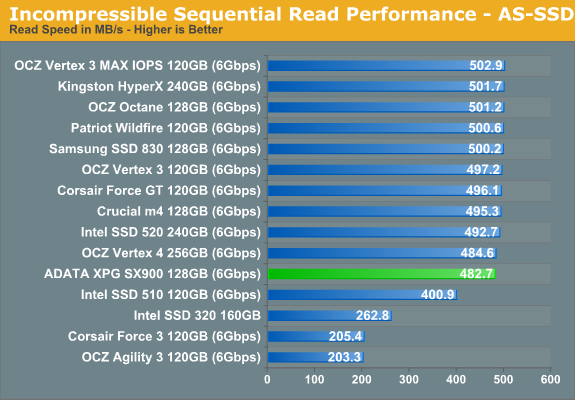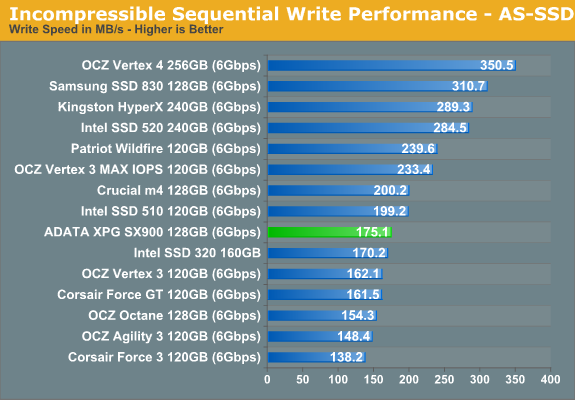ADATA XPG SX900 (128GB) Review: Maximizing SandForce Capacity
by Kristian Vättö on June 8, 2012 1:25 AM ESTAS-SSD Incompressible Sequential Performance
The AS-SSD sequential benchmark uses incompressible data for all of its transfers. The result is a pretty big reduction in sequential write speed on SandForce based controllers. Read speeds are largely unaffected.


No real surprises here. The SX900 is slightly faster than the 120GB OCZ Vertex 3 and Corsair Force GT, but this is most likely due to a newer firmware version (it's been a while since we tested Vertex 3 and Force GT). As you may have noticed, NAND plays a big role in SandForce incompressible performance. 240GB Kingston HyperX and Intel SSD 520 are the fastest, followed by 120GB Patriot Wildfire and OCZ Vertex 3 MAX IOPS, both of which utilize 3Xnm NAND. 3Xnm MLC NAND die tops out at 4GB, which means the Wildfire and Vertex 3 MAX IOPS have twice as many NAND dies as 120GB SSDs using 2Xnm MLC NAND. That gives them the benefit of interleaving.










58 Comments
View All Comments
vol7ron - Friday, June 8, 2012 - link
If you're going to put Mushkin up there, you might as well put OWC there too. Their drives seem to perform fairly well and are priced "decent"Kristian Vättö - Friday, June 8, 2012 - link
I only put Mushkin there because many have been asking for that since it appears to be one of the cheapest brands. OWC is not cheap, in fact even Vertex 3 is cheaper except the 480GB model. The table is endless if I start putting every brand there, plus checking the prices is PITA and already takes a decent amount of time.StevoLincolnite - Friday, June 8, 2012 - link
Plus... Only 4.52% of the worlds population resides in the USA, so the prices are pretty much useless for the 95.48% of the Earths population that doesn't reside in the US.StevoLincolnite - Friday, June 8, 2012 - link
To add to that, I don't mean to belittle your efforts, I just don't bother to look at the pricing on this site.jak3676 - Friday, June 8, 2012 - link
% of world population is hardly a useful stat to toss out there - you could make a decent argument with % of SSD's sold by country/region, but lets face it 99.99% of the world population (to include the US) isn't buying SSDs.If he listed prices in Euro or CAD or Yen or anything else he'd just be favoring that market (which is probably smaller than the US market anyway). Even if he could list prices available by country for the top 10 markets, he'd just turn off all of us as people wouldn't want to scroll through 10x the number of charts.
nathanddrews - Friday, June 8, 2012 - link
4.52% of the world's population, but 22% of the world's GDP. That's why US prices matter.JarredWalton - Friday, June 8, 2012 - link
And let's not forget that our site's primary readership *is* in the USA. I'm not sure of the breakdown, but I'd guess close to half of all our traffic is US based. Even if it's only 1/3 (Kristian for example is based in Finland), I doubt there's any other currency where our listing SSD prices in that denomination would prove more useful to our readers.Jaybus - Friday, June 8, 2012 - link
Yes, but some two thirds of international trades are in US dollars and it is still the de facto exchange currency.Anyway, what difference does it make? The point is relative prices between drives from different manufacturers. I don't think the ratios would change for different currencies.
djboxbaba - Saturday, June 9, 2012 - link
You realize this is a US based website right? and that the majority of the readership is based in the US?Go to a website that caters to your country's currency if this is a problem for you.
lyeoh - Tuesday, June 12, 2012 - link
Useless? Speak for yourself, some of us in the 95.48% know how to do currency conversion.Are you also going to claim the USD prices of oil, gold, silver, CPUs, DRAMs, etc are useless to the rest of the world?
There's plenty of stuff in the world that are priced in US dollars - as in the manufacturer's/producer's main selling price for the item is in US dollars. And the price in other countries is linked to that USD price. When the USD price goes up, their prices go up too.
If the petrodollar loses its hold (its slipping a bit) then it might make sense to use some other currency. That'll be bad for the USA as the US Gov will no longer be able "tax" other countries just by creating more US dollars.